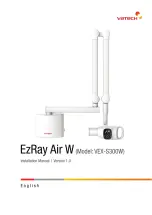4A.1 Vacuum Control System
4A.1.1 System Description
The VerusLab Lubricated Rotary Vane Laboratory
Vacuum System is U.L. labeled. The control panel
has a touch screen control, automatic lead/lag
sequencing (alarm option can be enabled or
disabled), external operators with circuit breaker
disconnects, full voltage motor starters, overload
protection, 24V control circuit, and automatic-
o
ff
-manual selector for each vacuum pump.
The control panel touchscreens display service
alerts, run hours for each vacuum pump, system
status, system vacuum level, and high discharge
air temperature. All components are enclosed in
a NEMA 12 enclosure.
4A.1.2 System Operation
The central vacuum system operates by
manipulating the pump(s) to supply the vacuum
requirements. The receiver tank is used as
a ballast to cushion the e
ff
ect of vacuum
consumption versus vacuum production. During
normal operation, all pumps should be in the
“AUTOMATIC” position so that the control system
can e
ff
ectively run the system.
The control system monitors the system vacuum
level, starts and stops the pumps depending
on changing vacuum level conditions, and
automatically alternates the lead position
WARNING:
Never run the pump without lubricating oil!
between units. Automatic alternation of all
vacuum pumps is based on
fi
rst-on / last-o
ff
principle with provisions for simultaneous
operation if required. The alternation timing
is
fi
eld adjustable between 4 to 24 hours with
factory setting at 10 hours (see Appendix A for
more details).
When vacuum is needed, it comes
fi
rst from
the receiver tank. Once the vacuum level drops
to the
fi
rst virtual pressure switch, the control
system will signal the lead pump to start. Virtual
pressure switches are system-de
fi
ned pressure
levels based on the maximum and minimum
vacuum set point as well as the number of pumps.
If the lead pump cannot raise or maintain the
vacuum level in the receiver, the next pump (lag
pump in a duplex) will start at the second virtual
pressure switch level. If vacuum continues to
fall, additional pumps will start after hitting the
subsequent virtual pressure switch levels (First
On / Last O
ff
).
A “Lag Alarm” (if enabled) occurs when the last
available pump starts. If the lag arm is activated,
the system will emit an audible alarm as well as
a visual alarm on the control panel. A complete
alarm and service history is available on the
control panel (see Appendix A for more details).
Note that if the lag alarm feature is disabled,
the lag alarm indicator will remain on the Alarm
screen (as seen in Figure 4A.1) but will remain
green (not go red) under any condition.
On the initial system start-up, when the system
vacuum level is below the set point of the vacuum
transducer, pump 1 will start immediately. The
next pump starts after a programmed time delay,
followed by the next pump until all pumps have
started. The time delay prevents high inrush
current after a power failure or emergency
power switch over. During this initial system
start-up, the lag alarm (if enabled) may come on
at this point and is normal. It can be reset once
4A.0
General Operation - TAe
Lubricated Rotary Vane Laboratory Vacuum Systems
4107 9021 88.01
4A-1
NOTE:
This section is only applicable to Lubricated
Rotary Vane Laboratory Vacuum Systems
with the TotalAlert Embedded electronic
control system.


















